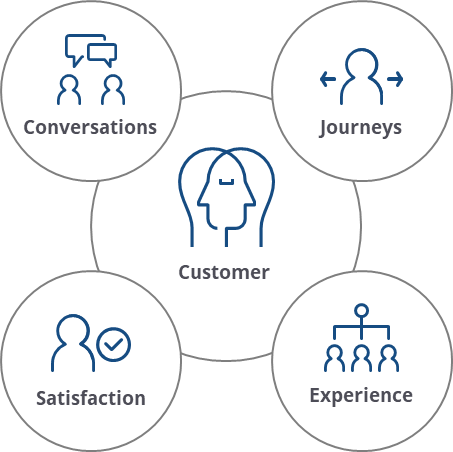The COVID-19 pandemic has reset, in a very short time frame, much of our daily lives and with it has altered, likely forever, how customers and brands engage and interact. As a result, brands will need to rethink what customer experience means and how they continue to engage and support their customers in this new reality.
News Highlights
The COVID-19 pandemic and the resulting global health crisis has resulted in significant disruption to every aspect of daily life. It has resulted in the declaration of numerous states of emergency, travel bans, closed borders, runs on consumers products, closure of schools, businesses, and churches, restrictions on public gatherings, and more.
The resultant shock to the economy will likely be long lasting as the delicate balance across the global supply chains are disrupted and the relationships with customers completely changed as customers either stay away or shift to being purely digital. For example, industries like entertainment, restaurants, travel, and hospitality have been ravaged and will be significantly altered into the future. It will be months and likely years before we fully recover from this disruption, and this disruption will alter the relationship between customer and brand forever.
The Four Keys to Engaging the Customer During COVID-19 and Beyond
With this pandemic the world has shifted in ways that won’t be clear for months and for years, and with it so have customer’s expectations and how brands and customers engage. Customers are looking for four things from brands and it is more important than ever now that brands deliver (see Figure).

These four keys to engaging the customer come from IDC’s work on the Future of Customers and Consumers: Empathetic Enterprise and are defined as:
- Conversations. Customers want a more human conversation where there is a clear exchange of information, knowledge, and understanding.
- Journey. Customers want and expect a clear, multi-channel journey with clear next steps and a clear outcome.
- Experience. Customers want brands to understand and apply context as a component of experience.
- Satisfaction. The customer has a need that they want fulfilled; regardless of the issues they want satisfaction.
To deliver those four items will require business models, organizations, and business processes to adapt to a new reality to maintain a level of trust and engagement with customers. This will diff by industry and by geographic area, but we believe that these are the four areas companies should be focusing on right now.
Begin with Empathy
We at IDC have been talking about Empathy at Scale, and specifically the role that technology can play in cognitive empathy or the ability to know and recognize another’s emotional state. And in normal times and normal markets, that would be enough. But today brands need to move beyond cognitive empathy for their customers and in these unique times actually apply emotional empathy or understanding of their emotional state and respond appropriately. How can companies do this? We recommend three actions:
- Be simple and clear in your communication. Now is not the time for overly complicated or opaque messages that can easily be misunderstood. Ensure all of your communications are simple and clear and give customers a channel to connect and engage with your brand if they have any questions. To quote something I was taught in the Army many years ago – tell them what you are going to tell them, tell them, and then tell them what you told them.
- Proactively engage your customers. Reach out them now, not tomorrow. It is appropriate and fine to start with an email but follow that up with a call. Yes, your customers are busy and under stress, and they may not want to talk with you in that moment. Simply let them know you are there and ready to help them if they need it.
- Let them know what you are doing. No customer should ever be surprised, so let them know what you are doing to support them and continue to be in business during this unique time. You should also let them know what they can do to help you. People like to help; it makes them feel better when they can. Offer your customers that opportunity.
Rest Goals and Targets
This is not business as usual, but brands can still be successful. Whatever your NPS score objectives are or other similar goals and targets were, they aren’t really relevant right now. Yes, brands need to stay in business, but the critical goals when it comes to customer experience are around reassuring your customers. Eventually we will return to a more normal process of measuring a brands engagement and satisfaction of the customer, but right now the priority needs to be focused on engagement. We recommend three actions to reset your targets and goals:
- Be clear on what is achievable. Be clear with both employees and customers what is achievable and what isn’t. Much better to under promise and over deliver in a time of crisis. For example, don’t tell a customer a product will be available in two days if you aren’t 120% sure.
- Revise targets and timelines. When necessary, revise targets and timelines for both employees and for customers. Be upfront about why and set clear expectations on when you will accomplish something.
- Communicate. Again, communicate constantly. And yes, people may get sick of it but better to over communicate and set clear expectations then not to and end up disappointing a customer.
Adapt Your Customer Experience to the New Reality
The customer experience you delivered yesterday should not and will not be the same kind of customer experience you will deliver tomorrow. Customer needs have changed along with the ability and channels for engaging with customers and delivering those experience. Three recommended actions for adapting the customer experience you deliver to this new reality are:
- Review. Review the current customer experiences against the new customer journey. What has changed, and what can be adopted.
- Simplify. Anything that can be done to simplify customer interactions and engagements should be done now. Anything that can be done to clarify customer engagements needs to be done.
- Test. Constantly test and retest. Customers will be changing and how they want to engage will be changing at a faster rate than normal. To maintain parity with customers requires constant testing and adaptation.
Support Employees in Supporting Your Customers
Employees are the front line for any customer experience, even digital ones. And like your customers, your employees are going through a lot right now. To bring a more human face to your customers requires presenting a more human face to your employees. We recommend these three actions for engaging employees that will echo out to your customers:
- Be patient. Be patient with employees as they face the same challenges as everyone else. This is a new type of challenge to what anyone has ever faced. By being patient leaders and managers can become a source of calm for their organizations that will reverberate out to their customers.
- Be flexible. Admittedly, you still have to run a business but being flexible with employees who are working from home for the first time or having to engage with customers for the first time will go a long way to maintaining your most important resource – your employees. And this flexibility should translate into more flexibility with your customers.
- Communicate. Clear communication internally is just as important as externally. The normal communications channels such as hallway conversations are gone. This requires leadership to communicate more frequently and more regularly.
The coronavirus (COVID-19) pandemic is impacting the global economy at nearly every level. Anticipate market challenges and keep business moving with IDC’s extensive COVID-19 research and advice.




